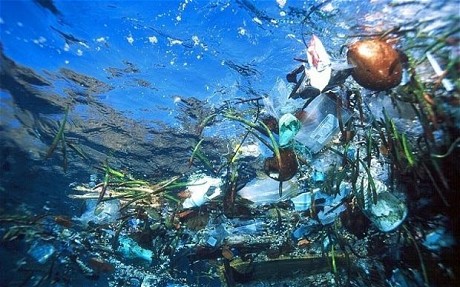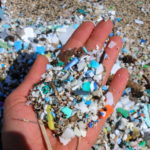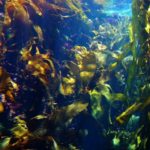While the Great Pacific Garbage Patch continues to grow, a paper by researchers at the Monterey Bay Aquarium Research Institute shows that trash is accumulating in the deep sea, particularly in Monterey Canyon, off the coast of California. This causes dire impacts to the marine ecosystem and humans who thrive from it. Following is a story by Judy Molland and a video by Paulie Z and the Harbour School of Hong Kong.


Pacific Ocean Floor Is A Huge Underwater Garbage Dump
Judy Molland, Report Published in Care2
It’s old news that plastic bags, aluminum cans and fishing debris not only clutter our beaches, but accumulate in open-ocean areas such as the “Great Pacific Garbage Patch” (basically a giant vortex of plastic soup, roughly twice the size of Texas). So much for the myth of the beautiful, natural ocean, stretching off towards the horizon.
Now, a paper by researchers at the Monterey Bay Aquarium Research Institute (MBARI) shows that trash is also accumulating in the deep sea, particularly in Monterey Canyon, off the coast of California. The horrific report was produced using over 18,000 hours of footage from deep sea remotely-operated vehicles, over a period of 22 years; cameras examined the ocean floor as deep as 13,000 feet and found human-made garbage everywhere.
The Pacific Ocean, which for many carries connotations of beauty and romance, is in fact a huge underwater garbage dump.
httpvh://youtu.be/xlqi58MV3yQ
SONG Written by: Paulie Z, Tony Cortes, The Harbour School Hong Kong. Produced by: Paulie Z. Recorded, mixed and mastering by: Tarr Shiu at Frenzi Music Studios.
Kyra Schlining, lead author on this study, said, “We were inspired by a fisheries study off Southern California that looked at seafloor trash down to 365 meters. We were able to continue this search in deeper water—down to 4,000 meters. Our study also covered a longer time period, and included more in situ observations of deep-sea debris than any previous study I’m aware of.”
Deep sea vehicles viewed dive sites all along the West Coast from the Gulf of California to Vancouver Island and all around the Hawaiian Islands. However, rather than finding random piles of trash all across the Pacific seafloor, researchers discovered that debris accumulates mostly in deep sea slopes and rocky areas. They found the worst accumulation of plastic, metal, fishing debris and other trash lay in Monterey Canyon off the California coast.
The fact is, as a society, we only reclaim about five percent of our plastics, according to 5 Gyres, which studies the impact of ocean plastic pollution. Of the remainder, 50 percent ends up in landfills, and the rest is “lost in the environment, where it washes out to sea.”
“I was surprised that we saw so much trash in deeper water. We don’t usually think of our daily activities as affecting life two miles deep in the ocean,” said lead author of the study Kyra Schlining. “I’m sure that there’s a lot more debris in the canyon that we’re not seeing. A lot of it gets buried by underwater landslides and sediment movement. Some of it may also be carried into deeper water, farther down the canyon.”
How Does Garbage Affect Ocean Life?
There is already evidence that the Great Pacific Garbage Patch causes real problems for members of the ocean ecosystem, both above and below the surface. In addition to killing birds and fish who try to eat it, new research suggests that the floating trash is giving a certain variety of marine insect an ideal place to breed out on the open ocean, and this could have a big impact on the environment at the surface of the ocean.
In the deep sea environment, the Monterey Bay research team found plastic was the most common material found. Of the plastic items, about half were plastic grocery bags. These increasingly controversial items can choke and smother animals.
Metal objects were the second most common. Of them, about two thirds were aluminum, steel or tin cans. Discarded fishing equipment was also commonly observed, along with glass bottles, papers, cloth and even a shipping container that fell off a ship in 2004. Inside the container are over 1,000 steel-belted tires.
Due to the nature of the plastic waste (mostly translucent pieces the size of your fingernail) and the impracticality of hauling it all the way from the Gyre, scientists have determined that it would cost more resources than it would conserve to try and clean up the patch.
The impacts of deep-sea trash may last for years. Near-freezing water, lack of sunlight, and low oxygen concentrations discourage the growth of bacteria and other organisms that can break down debris. Under these conditions, a plastic bag or soda can might persist for decades. With the cost of removing all this trash prohibitively expensive, Schlining wants to use this information to educate people on the importance of not introducing litter into the marine environment.
Los Angeles Bans Plastic Bags
To this end, several cities and counties have banned free plastic bags, and Los Angeles became the biggest city in the country to ban free plastic bags in grocery stores. Shoppers in the city will have to tote their own bags, or pay 10 cents each for paper bags. About $2 million a year is spent to clean up plastic bag litter in Los Angeles, where an estimated 228,000 bags are distributed every hour.
On the downside, even though Bette Midler was at the California Senate, leading a star-studded fight against the use of plastic bags in California supermarkets, the bill fell three votes short of the tally needed for passage. If you are as disgusted as I am by the knowledge that we are creating huge piles of garbage in our oceans, please make sure you don’t litter our beaches with plastic bags, or anything else.
We can make a difference.
VIDEO
Produced and Directed by: Paulie Z and The Harbour School Hong Kong
Filmed by: Aaron Michelson
Edited by: Brad Wayburne













This brings tears to my eyes, just like that YouTube video of the guy on the island thousands and thousands of miles from human civilization cutting open a seabird and finding all sorts of man made products inside.
Pingback: Assignment 5, Stage 1 – defining the trend | Textiles2OCA